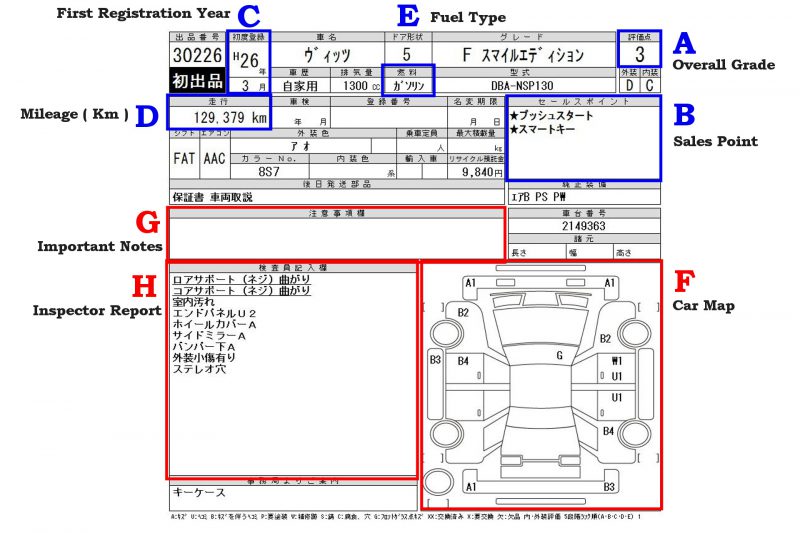Vehicles in Japanese auto auctions are inspected by qualified and trained inspectors. These inspectors are employed by the auction itself, not by the seller. The auction report, or auction sheet, provides a snapshot of the condition of the vehicle.
What information is on the auction sheet?
The first thing you notice is that you can hardly read because it is written in Japanese.
Please do not worry.
Even if you do not understand Japanese, you can understand the state of the car if you understand the points to see.
As shown on the left, the report is divided into sections, so I will explain each section.


Section A
Shows the overall rating of the car.Basically, 1 to 5 are also represented by numbers.The higher the number, the higher the rating.There is also evaluation in the alphabet.S represents a new car. R represents an accident vehicle.
Section B
Selling points is include car accessories.This includes push start , smart keys and back camera etc.This is a positive section.
Section C
Here is the registration date.Often written in the Japanese calendar.
Japanese calendar H30 is 2018 in the Christian era
Japanese calendar R01 is 2019 in the Christian era
Section D
The mileage. The unit is KM
Section E
Fuel type. In Japanese, it is written as follows.

Section F
The car map shows places such as scratches and dents on the car surface with symbols.
Symbol meaning
| A:Scratch | U:Dent | B:Dent with scratch |
| P:Painting required | W:Repair mark | S:Rust |
| C:Corrosion | G:Windshield scratch | X:Exchange required |
| XX:Replaced part |
Number meaning
| 1:Small | 2:Medium | 3:Large | 4:Extra large |
Section G
Contains important notes from exhibitors.
Vehicle breakdowns and defects are specifically described
If there is a shortage of standard equipment, or if there is an external product, enter the details.
Many sellers enter sales points that did not fit into the sales points.
Section H
Write down any negative points that the inspector notices when checking the vehicle.
In Japanese, it is written as follows.



